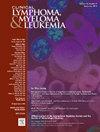社会经济地位和医疗资源可获得性对老年(≥66岁)非西班牙裔黑人与非西班牙裔白人多发性骨髓瘤患者生存的影响
IF 2.7
4区 医学
Q2 HEMATOLOGY
引用次数: 0
摘要
背景:几种因素导致了非西班牙裔黑人(NHB)和非西班牙裔白人(NHW)多发性骨髓瘤(MM)患者总生存期(OS)的已知差异。患者和方法:为了探讨社会经济地位(SES)和医疗资源(HCR)可用性是否影响OS,本回顾性研究使用相关的监测、流行病学和最终结果(SEER)-医疗保险索赔和地区卫生资源文件来识别年龄≥66岁的MM(新诊断为2013年6月1日- 2017年12月31日)的NHB和NHW患者。在2019年12月31日或死亡之前,需要连续的医疗保险A和B登记。结果:共识别6609例患者;15.6%为NHB。在基线时,NHB患者更年轻,更可能是女性,有更高的查理森合并症指数(CCI),更可能生活在人口普查区,教育程度较低,贫困比例高于NHW患者。NHB患者与NHW患者按种族/民族划分的未调整中位OS分别为2.76年和3.01年(风险比[HR]: 1.08;P = .063)。在调整后的模型中,诊断时年龄越大(P < .001)、男性(P = .02)和CCI越高(P < .001)会增加死亡风险。贫困(P = .02)和每10万名在职医生人数(P = .003)具有显著性,但无临床意义。经人口统计学、社会经济地位和人力资源管理(HCR)可用性调整后,种族OS人力资源具有相反的方向性(HR: 0.92; = 点页)。结论:包括SES和HCR可用性在内的几个因素显著影响OS,并可能导致MM患者的护理差异。需要进一步研究更大的数据集。本文章由计算机程序翻译,如有差异,请以英文原文为准。
Effects of Socioeconomic Status and Healthcare Resource Availability on Survival in Older (≥66 years) Non-Hispanic Black Patients Versus Non-Hispanic White Patients With Multiple Myeloma
Background
Several factors contribute to the known disparities in overall survival (OS) between non-Hispanic Black (NHB) patients and non-Hispanic White (NHW) patients with multiple myeloma (MM).
Patients and Methods
To explore whether socioeconomic status (SES) and healthcare resource (HCR) availability impacts OS, this retrospective study used linked Surveillance, Epidemiology, and End Results (SEER)-Medicare claims and Area Health Resource Files to identify NHB and NHW patients aged ≥66 years with MM (newly diagnosed 6/1/2013-12/31/2017). Continuous Medicare A and B enrollment until 12/31/2019 or preceding death was required.
Results
In total, 6,609 patients were identified; 15.6% were NHB. At baseline, NHB patients were younger, more likely to be female, had higher Charlson Comorbidity Index (CCI), and were more likely to live in census tracts with lower education attainment and higher poverty percentages than NHW patients.
Unadjusted median OS by race/ethnicity for NHB patients versus NHW patients was 2.76 versus 3.01 years (hazard ratio [HR]: 1.08; P = .063). In the adjusted model, older age at diagnosis (P < .001), male sex (P = .02), and higher CCI (P < .001) increased risk of death. Poverty (P = .02) and number of active medical doctors per 100,000 (P = .003) were significant but not clinically meaningful. OS HR by race reversed directionality when adjusted for demographics, SES and HCR availability (HR: 0.92; P = .12).
Conclusion
Several factors, including SES and HCR availability, significantly influenced OS and may drive disparities in care for patients with MM. Further research on larger datasets is needed.
求助全文
通过发布文献求助,成功后即可免费获取论文全文。
去求助
来源期刊

Clinical Lymphoma, Myeloma & Leukemia
ONCOLOGY-HEMATOLOGY
CiteScore
2.70
自引率
3.70%
发文量
1606
审稿时长
26 days
期刊介绍:
Clinical Lymphoma, Myeloma & Leukemia is a peer-reviewed monthly journal that publishes original articles describing various aspects of clinical and translational research of lymphoma, myeloma and leukemia. Clinical Lymphoma, Myeloma & Leukemia is devoted to articles on detection, diagnosis, prevention, and treatment of lymphoma, myeloma, leukemia and related disorders including macroglobulinemia, amyloidosis, and plasma-cell dyscrasias. The main emphasis is on recent scientific developments in all areas related to lymphoma, myeloma and leukemia. Specific areas of interest include clinical research and mechanistic approaches; drug sensitivity and resistance; gene and antisense therapy; pathology, markers, and prognostic indicators; chemoprevention strategies; multimodality therapy; and integration of various approaches.
 求助内容:
求助内容: 应助结果提醒方式:
应助结果提醒方式:


